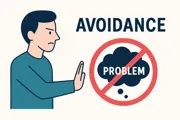

When we talk about avoidance, what exactly are we referring to? It is a solution, a strategy put in place by an individual to avoid problematic situations, people who may cause difficulties, or contexts that could generate tension. In essence, it is a voluntary retreat from events or interactions that may cause anxiety or fear that one does not feel ready to handle.
However, this behavior should not be seen exclusively as negative. Sometimes, avoiding potentially harmful or dangerous situations can be a positive and evolutionary response that helps us protect ourselves from environments we might otherwise struggle to manage appropriately.
If avoidance is used to escape genuinely risky situations, it may be helpful. But when it becomes the only way an individual manages life, it turns into a defensive mechanism that impairs daily functioning. It becomes a strategy to protect the mind from situations perceived as unmanageable.
In practice, this strategy is a behavioral response intended to regulate emotional overload. The goal is to avoid negative emotions or stressful stimuli that could compromise a person’s mental stability. It is often seen in individuals with anxiety disorders, particularly social phobia.
Everyone has used avoidance at some point. Rational individuals weighing pros and cons might use it temporarily to avoid danger or stress. But when avoidance becomes the only option, it signals an unhealthy response to adversity.
Over time, this leads to a vicious cycle: the individual feels increasingly incapable of managing difficult situations, which fuels more avoidance. They believe they must escape every complex or emotionally loaded event instead of developing resilience or adaptive coping strategies.
This type of avoidance stems from an internal effort to control emotions and sensations. Although it may seem protective in the short term, it often results in greater psychological distress, as the person limits experiences that could promote growth or healing.
A person experiencing depression might find it difficult to handle daily responsibilities—work, relationships, errands. Psychological symptoms like apathy, anxiety, low self-esteem, or memory issues can prompt them to avoid entire domains of life, creating a harmful pattern.
Although avoidance might feel like the easiest solution, it eventually becomes a psychological cage. The person gives up on everyday challenges, which worsens their sense of competence and self-worth. Therapy must work to reintroduce the individual to situations they fear through progressive exposure.
People with social anxiety are often hypersensitive to judgment, criticism, or perceived inadequacy. To prevent exposure to these fears, they limit social interactions, reinforcing avoidance and deepening isolation. Therapy must challenge these patterns carefully and gradually.
In some cases, fear of not meeting expectations in relationships or professional settings leads to social withdrawal. Individuals may avoid advancement opportunities or close emotional bonds due to chronic feelings of inadequacy.
Psychotherapeutic support is necessary for individuals dealing with pathological avoidance. Therapy helps identify the triggering contexts and exposes the patient to emotional challenges that promote insight and recovery.
These individuals often anticipate rejection or criticism in personal or professional relationships, leading to chronic social withdrawal. In the workplace, they may avoid meetings, feedback sessions, or opportunities for leadership, fearing they will not meet expectations. This avoidance limits career advancement and reinforces feelings of inadequacy. In romantic relationships, they may struggle to express emotions or establish intimacy, as vulnerability is perceived as a threat. Over time, this pattern leads to deep isolation and emotional detachment.
One of the most effective strategies to address avoidance is the concept of acceptance. Patients are encouraged to recognize and tolerate discomfort without resorting to escape. This process, though painful, is essential for building psychological flexibility. The therapist may introduce exercises based on exposure hierarchy, where patients progressively face avoided situations starting from the least threatening to the most challenging. This gradual desensitization reduces the emotional impact of feared contexts and helps rebuild self-confidence.
This psychological method gradually introduces the patient to situations that cause anxiety or avoidance. The therapeutic alliance is essential, but patients may resist by arriving late or acting out. The goal is to foster acceptance: opening up to discomfort instead of escaping it. Avoiding problems adds suffering rather than resolving it. The ultimate risk is ceasing to fully live.
You can find additional information in the Wikipedia article on social anxiety disorder.

Avoidance is a behavior used to escape social situations perceived as threatening. For people with social anxiety, it becomes a way to avoid negative judgment, but it often worsens distress over time.
People with social anxiety may avoid meetings, exams, phone calls, or social outings. It becomes problematic when it limits personal or professional functioning.
Not always. Avoidance can be a healthy strategy to manage emotional overload. But when it becomes rigid and isolating, it may indicate an anxiety disorder.
Cognitive-behavioral therapy (CBT) is effective. A common technique is gradual exposure, where patients face avoided situations step-by-step in a controlled way.